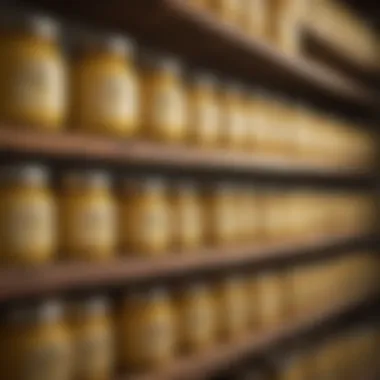Where to Buy Ghee Butter: A Comprehensive Guide


Intro
Ghee butter has gained significant attention for both its culinary versatility and health benefits. Traditionally used in Indian cuisine, ghee is made by simmering unsalted butter to separate milk solids from butterfat. This results in a rich, aromatic product that enhances flavors in various dishes. Therfore, purchasing ghee can seem straightforward, yet the options available can be overwhelming.
This comprehensive guide covers where to buy ghee butter, detailing various retail environments and online options. It also emphasizes the essential factors to consider when making a purchase, including quality, sourcing, and price. Additionally, as the trend for homemade ghee becomes more popular, insights into the preparation process will be shared. This guide aims to equip readers with valuable insights for making informed decisions, catering to diverse culinary needs and preferences.
Where to Purchase Ghee Butter
Finding quality ghee can be done through multiple avenues. The common options include grocery stores, specialty shops, and online platforms.
Grocery Stores
Many supermarkets now carry ghee in their specialty sections, especially those with a focus on organic and health-conscious products. Look for brands like Kerrygold, Organic Valley, or Tin Star Foods. Freshness and packaging can vary greatly, often influencing quality. Some chains might even have store-brand ghee, which is typically less expensive but can vary in flavor and texture.
Specialty Shops
Consider visiting specialty food stores or ethnic markets. These locations often offer artisanal or locally sourced ghee. Besides, the shop owners can usually provide insights about the production methods and sourcing of their products. Purchasing from a specialty shop allows you to try a variety of flavors and styles, enhancing your culinary experience.
Online Platforms
With the rise of e-commerce, buying ghee online is more accessible than ever. Websites such as Amazon or Thrive Market have extensive selections. When ordering online, make sure to review product descriptions and customer feedback to inform your choice. Authority sources like Wikipedia or Britannica can provide general knowledge about ghee, while platforms such as Reddit can give personal experiences and brand rating from fellow food lovers.
"Ghee is not only beloved for cooking but is also celebrated for its long shelf life as it does not require refrigeration."
Factors to Consider When Choosing Ghee
When selecting ghee butter, several key factors can influence the quality of the final product.
- Quality: Look for labels that indicate organic or grass-fed cows, as these factors can enhance flavor and nutritional content.
- Sourcing: Try to purchase products that source their butter from reputable farms. This not only supports ethical practices but often leads to better tasting ghee.
- Price: While higher price does not always guarantee better quality, extremely low-priced options may raise concerns regarding sourcing and ingredient quality. Be cautious and do research when choosing budget options.
Trend of Homemade Ghee
With the growing trend of homemade ghee, many find it rewarding to create their own. Preparing ghee involves simple steps that allow customization in terms of flavor intensity and texture.
- Ingredients Needed: Unsalted butter is the primary ingredient. The amount can vary based on how much ghee is desired.
- Preparation Process: Melt the butter in a saucepan over low heat. Allow the butter to simmer until the milk solids settle and turn golden brown while being careful not to scorch them. After straining the liquid from solids, the ghee is ready.
Homemade ghee can provide a fresher taste and the satisfaction of creating a staple that promotes health and culinary creativity.
Preface to Ghee Butter
Understanding ghee butter is essential for anyone interested in culinary practices and health. Ghee, a type of clarified butter, carries a rich history, particularly in Indian cuisine. It is revered not just for its taste but also for its adaptability in various cooking methods, such as frying, baking, and even in salad dressings. This section will explore its definition and significance in modern diets.
What is Ghee Butter?
Ghee butter is essentially butter that has been simmered to remove its water content and milk solids. During this process, it develops a unique, nutty flavor. Ghee differs from regular butter both in its composition and nutritional profile. The result is a product that boasts a high smoke point, making it ideal for cooking at high temperatures without degrading the fat.
The traditional method of making ghee involves using unsalted butter, typically from cows. Once heated, the butter separates into three layers: water, milk solids, and the golden liquid fat, which is the ghee. The milk solids are strained away, leaving behind the pure fat. This purity grants ghee a long shelf life, enabling it to remain stable at room temperature for extended periods, unlike standard butter, which requires refrigeration. Ghee is often seen as a staple in South Asian kitchens, but its popularity has grown internationally, especially as people become more aware of dietary fats and their effects.
Health Benefits of Ghee Butter
Ghee butter carries several potential health benefits. It is rich in fat-soluble vitamins such as A, D, E, and K. These vitamins play critical roles in various bodily functions, including maintaining healthy vision, skin, immune function, and calcium absorption. Moreover, ghee is a source of butyrate, a short-chain fatty acid that supports gut health by nourishing the cells lining the intestines.
Some other potential benefits include:
- Lactose-Free: The clarification process removes nearly all lactose and casein, making ghee suitable for those with dairy sensitivities.
- Rich in Conjugated Linoleic Acid (CLA): This compound is sometimes linked to various health benefits, including weight management and improved immunity.
- Source of Omega-3 Fatty Acids: Ghee made from grass-fed cows can provide a beneficial amount of omega-3s.
"Incorporating ghee butter into your diet can enhance not just flavor but also boost nutritional richness in meals."
Thus, ghee butter represents not only a versatile ingredient for cooking but also a functional food, providing various health benefits worth considering. Understanding ghee butter can make you a more informed consumer, whether you are purchasing it or making it at home.
Retail Options for Ghee Butter


Exploring where to buy ghee butter is crucial for anyone looking to incorporate this versatile ingredient into their culinary repertoire. Various retail options exist, each with unique benefits and considerations. Understanding these avenues can greatly enhance the buying experience. Furthermore, the choice of retailer can impact the quality, pricing, and sourcing transparency of the ghee. Therefore, engaging with different retail environments allows consumers to make informed decisions based on their preferences and needs.
Local Grocery Stores
Local grocery stores are often the most accessible option for purchasing ghee butter. They provide a familiar shopping environment where consumers can quickly find what they need.
Identifying Popular Grocery Chains
Identifying popular grocery chains is essential as they frequently stock ghee butter. Chains like Whole Foods, Safeway, or Kroger tend to carry a variety of brands. These stores usually have dedicated sections for organic products, where ghee can often be found.
A key characteristic of these grocery chains is their extensive distribution network, allowing for convenience. However, not all stores may stock high-quality ghee, limiting choices for discerning customers.
Product Availability and Selection
Local grocery stores typically have a wide product availability and selection of ghee butter. The assortment varies by region and chain, with some stores stocking both conventional and organic varieties. This gives consumers the option to choose based on their dietary preferences.
However, the unique feature here is the potential lack of niche brands. While standard brands might be widely available, specialty or artisanal ghee may not be present, which can be a disadvantage for those seeking quality.
Pricing Considerations
Pricing considerations in local grocery stores can be quite variable. Some chains may offer competitive pricing, especially during sales, while others may price ghee higher due to brand reputation or perceived quality.
A beneficial aspect of grocery stores is the ability to compare prices in person. However, the disadvantage here is that lower prices may not always reflect the best quality, leading to a compromise when making a choice.
Specialty Food Stores
Specialty food stores focus on unique or gourmet food products and often have a curated selection of ghee butter. This makes them an excellent choice for quality seekers.
Exploring Health Food Stores
Health food stores specifically cater to those seeking organic or health-focused food products. Popular establishments like Sprouts Farmers Market typically stock various types of ghee.
A critical characteristic of these stores is their emphasis on organic products. Thus, shoppers often find ghee with high-quality ingredients. However, the exclusivity may lead to higher prices compared to standard grocery chains.
Artisan Markets and Delis
Artisan markets and delis are another appealing option. These venues often sell locally sourced or handmade products, giving customers access to specialized ghee.
A key aspect is the personal touch involved in the products they carry. Many of these markets pride themselves on sourcing from local producers, thus guaranteeing freshness. Nonetheless, availability may be limited due to seasonal production.
Benefits of Sourcing from Specialty Stores
Sourcing from specialty stores offers several benefits. The focus on quality and ethics in ingredient sourcing is usually paramount in these settings, appealing to conscientious consumers.
With specialty stores, customers can often find a variety that includes unique flavor profiles. However, some may find these options typically come at a premium price.
Farmers Markets
Farmers markets present a direct way to purchase ghee butter while supporting local producers. These markets allow consumers to engage with makers and understand more about their products.
Local Producers of Ghee
Engaging with local producers of ghee can lead to discovering craftsmen who specialize in artisanal methods. Such producers often prioritize quality and ethical sourcing practices.
A significant aspect of this option is the connection to the community and sustainability. However, choices may be based on what is seasonally available and could limit options compared to grocery stores.
Advantages of Buying Directly from Producers
Buying directly from producers has definite benefits. It allows consumers to learn about the production process and the sourcing of ingredients firsthand. This transparency can enhance trust in the product.
However, the downside is that not all areas may have local producers, limiting access for some consumers.
Seasonal Availability


Seasonal availability is an important factor when considering farmers markets. This can directly affect the types of ghee available. Producers may have specific seasons for making ghee, affecting overall access.
A unique feature of this option is the freshness of the product, which is often richer in flavor. However, seasonal limits mean consumers may have to plan their purchases in advance.
Online Purchasing of Ghee Butter
Online purchasing has become a significant method for many people seeking ghee butter. The convenience of shopping from home is one of the main advantages. Shoppers can easily compare products, prices, and read reviews. Additionally, online platforms often showcase a wider range of brands than local stores. For those who may not have access to specialty stores in their area, online shopping fills that gap. Considerations like shipping duration and costs, however, must not be overlooked.
E-commerce Platforms
Leading Online Retailers
Leading online retailers such as Amazon, Walmart, and Thrive Market play a crucial role in the ghee butter market. These platforms offer a vast selection of brands and types. Shoppers can find organic, flavored, or traditional ghee butter all in one place. One key characteristic is the ability to read customer reviews right next to the product, which greatly informs purchasing decisions. However, consumers must navigate choices carefully, as not every retailer may carry high-quality products.
Comparison of Prices and Brands
Comparing prices and brands is another vital aspect of purchasing ghee butter online. With just a few clicks, consumers can see many options side by side. This comparison not only helps find the best deal but also exposes shoppers to timely deals and discounts. The main benefit is the potential for significant savings on bulk purchases. On the downside, it may become overwhelming due to the sheer volume of choices, leading to analysis paralysis.
Delivery Options and Shipping Costs
Delivery options and shipping costs significantly impact online buying decisions. Some retailers offer free shipping, which can sway buyer behavior. Fast delivery options are also appealing, especially for perishable items like ghee butter. Understanding the costs involved before making a purchase is crucial. While some may find it cheaper online, shipping fees can sometimes negate those savings.
Direct from Manufacturers
Buying ghee butter directly from manufacturers can offer many advantages for consumers. It creates a direct line of communication between them and the producer.
Advantages of Buying from Producers
The advantages of buying from producers include access to fresher products. Manufacturers often have more straightforward supply chains, allowing their products to reach consumers faster. Many producers also offer a more personalized shopping experience. However, the downside may be limited options compared to larger retailers.
Understanding Brand Integrity
Understanding brand integrity is essential for confident purchasing. Direct purchases allow consumers to verify the source of the ghee butter. This verification can encompass ethical sourcing and quality control measures. Knowing the story behind the product can also enhance consumer trust. On the flip side, some manufacturers may not offer the same range of choices as large online platforms.
Organic Certification and Sourcing
Lastly, the importance of organic certification and sourcing cannot be overstated. Buying directly ensures that consumers can know if their ghee butter is certified organic. This factor appeals to health-conscious shoppers looking for quality products. While not all brands may carry this certification, the possibility of accessing transparent sourcing practices is a substantial benefit. Conversely, such offerings might come at a higher price point.
Factors to Consider When Buying Ghee Butter
When looking to buy ghee butter, there are several factors that can significantly impact your satisfaction with the product. Understanding the quality, price variations, and sourcing transparency can help ensure that you choose a ghee butter that meets your culinary and nutritional needs. This section discusses what to consider while making your purchasing decision, emphasizing the importance of these factors.
Quality Indicators
Color and Aroma
The color and aroma of ghee butter are crucial indicators of its quality. A high-quality ghee should have a golden yellow to deep amber hue, signifying good production methods and natural ingredients. Its aroma should be rich and slightly nutty, representing the caramelization of milk solids that occurs during the making process. The unique feature of color and aroma in ghee is how they can directly affect its taste and usage in dishes. Choosing ghee with the right aroma and color is beneficial because it ensures a better flavor in your cooking, enhancing recipes rather than overpowering them.
Texture and Consistency
In addition to color and aroma, texture and consistency play important roles in determining the quality of ghee butter. High-quality ghee will be smooth and creamy, easily spreadable, and stable at room temperature. It should not be grainy or have a watery texture, which might suggest poor processing or additives. The silky consistency contributes to its versatility in cooking. For instance, a well-textured ghee can be used as a cooking fat, in baking, or simply spread on toast. Maintaining the right texture ensures a delightful culinary experience.
Price Variations
Understanding Cost Factors
When it comes to ghee butter, price variations can stem from several cost factors. These include the quality of ingredients used, the production process, and the brand's reputation. Understanding these factors is essential for making informed purchasing choices. For instance, ghee made from grass-fed cows may come at a premium price but is often higher in beneficial nutrients. Weighing these aspects is key to understanding why one product might cost more than another.
Identifying Value for Money
Identifying value for money involves evaluating what you're getting for the price you pay. Sometimes, a lower price may attract attention, but it may not always reflect the actual quality of ghee. It is crucial to assess whether the flavors, sourcing practices, and health benefits justify the price. Consider also factors such as packaging and serving size. Taking the time to analyze these elements can lead to more informed buying decisions and can prevent costly mistakes.


Sourcing Transparency
Traceability of Ingredients
Traceability of ingredients is vital when buying ghee butter. Knowing where the milk comes from and how it is processed allows consumers to make ethical and informed choices. Good ghee should have clear labeling that indicates its source and any certifications it might hold. This contributes not only to its quality assurance but also to responsible consumption. An important characteristic of traceability is confidence; consumers can be more comfortable knowing their food is sourced from reputable producers.
Ethical Considerations in Sourcing
Ethical considerations in sourcing go beyond ingredient traceability. This involves understanding the farming practices used, the treatment of animals, and sustainable operations. A product that prides itself on ethical sourcing will often carry certifications such as organic or fair trade. These ethical practices can enhance the overall appeal of the ghee butter, aligning with consumer values. By selecting brands that prioritize ethical sourcing, you contribute positively to the food industry.
Making Ghee Butter at Home
Making ghee butter at home is an attractive option for many individuals interested in culinary practices. The process allows for control over ingredient quality and customization that store-bought options cannot provide. Homemade ghee is not only fresh but also cost-effective and can fit personal taste preferences. Furthermore, there is a certain satisfaction that comes from creating a staple ingredient in one's own kitchen.
Essential Ingredients and Equipment
Selecting Quality Butter
Selecting quality butter is critical when making ghee. The flavor and overall quality of the final product largely depend on the type of butter used. Grass-fed butter, for instance, is recommended for its rich flavor profile and higher nutritional content. This butter typically contains more omega-3 fatty acids and vitamins, making it a popular choice for health-conscious consumers. Using regular butter may yield a more bland taste and less nutritional value.
Necessary Kitchen Equipment
Necessary kitchen equipment for making ghee includes a heavy-bottomed pan and a fine mesh strainer. A heavy-bottomed pan ensures even heating, preventing the butter from scorching. This equipment is essential because improper heating leads to burnt ghee, which can ruin the taste. While a fine mesh strainer is used to separate the liquid ghee from solid milk solids, ensuring a clear final product.
Step-by-Step Guide to Homemade Ghee
Preparing the Butter
Preparing the butter involves measuring out the quantity needed for the ghee. Typically, one pound of butter is an efficient starting point for homemade ghee. Proper preparation ensures a controlled and successful cooking process. The key aspect here is to start with cold butter and cut it into smaller cubes to facilitate even melting.
Cooking Process and Monitoring
The cooking process requires patience and constant monitoring. It is crucial to keep the heat on medium-low, as high temperatures can lead to burning. During cooking, the butter will begin to foam, and milk solids will sink to the bottom. Monitoring closely allows one to catch the right moment when the milk solids turn golden brown, signifying that ghee is ready for straining.
Straining and Storing Ghee
Straining and storing ghee is the final step in the process. Using a fine mesh strainer or cheesecloth helps to catch the milk solids, leaving only the clear golden liquid. Once strained, it is important to store ghee in a clean, dry glass container. Ghee can be kept at room temperature for several months, making it convenient for frequent use. This advantage complements the attraction of homemade ghee, as it has a long shelf life.
Benefits of Homemade Ghee Butter
Customization Options
Homemade ghee butter provides ample customization options. One can infuse flavors by adding herbs or spices during the cooking phase. This personalization elevates the ghee to suit individual preferences and culinary needs. Customization allows for a unique taste profile that cannot be replicated with store-bought ghee.
Cost-effectiveness
Cost-effectiveness is another reason to consider making ghee at home. While purchasing premium ghee can be pricey, making it from high-quality butter at home typically brings down the cost per serving. Additionally, one can produce larger batches, further maximizing savings in the long run. This financial benefit makes homemade ghee an appealing choice for many.
Ending
In this article, we have explored various avenues for purchasing ghee butter, significantly broadening your options. Understanding where to buy ghee butter is crucial for those seeking its many culinary benefits and health advantages. The choices we discussed range from local grocery stores, specialty food outlets, to online platforms. Each purchasing option presents unique benefits and considerations, making it essential for consumers to discern what fits their needs best.
Ultimately, the summary of purchasing options highlights the availability of ghee butter across different retail settings. Whether you prefer the convenience of online shopping or the personal touch of farmers markets, there is a suitable choice for everyone. Additionally, assessing the quality indicators, price variations, and sourcing transparency helps ensure that you select a high-quality product that aligns with your preferences.
Recap of Purchasing Options
Each channel for buying ghee butter offers distinct advantages:
- Local Grocery Stores: Easy access and a variety of brands. Typically, these stores carry popular ghee butter brands, making them a convenient option.
- Specialty Food Stores: Often stock organic or artisan brands, providing higher-quality options. They can cater to those seeking unique flavors or sustainable sourcing.
- Farmers Markets: Direct purchases from producers allow you to support local businesses and gain insight into the product’s sourcing.
- Online Purchasing: E-commerce platforms provide a broader selection and the ability to compare prices across multiple brands. Purchasing directly from manufacturers can deliver quality assurance and information about sourcing.
Understanding these options helps consumers make informed decisions based on their preferences and values.
Encouragement to Explore Homemade Options
While purchasing ghee butter is convenient, making it at home offers a rewarding experience. Homemade ghee butter allows for customization of flavor and quality adjustments based on personal preferences. The process is relatively simple and can often be more cost-effective than store-bought options.
Consider the benefits of trying your hand at creating your own ghee:
- Full control over the ingredients used.
- Ability to tailor the flavor and aroma to your liking, possibly enhancing recipes.
- A deeper connection to your food and cooking process.















